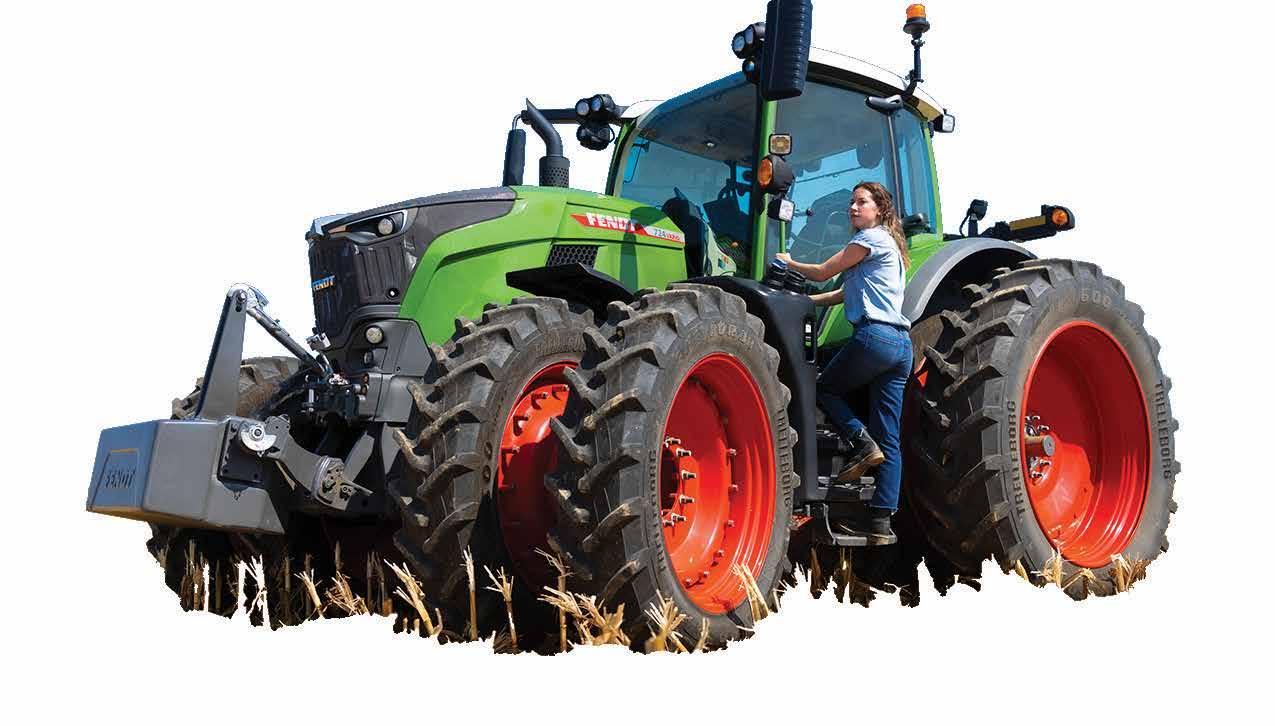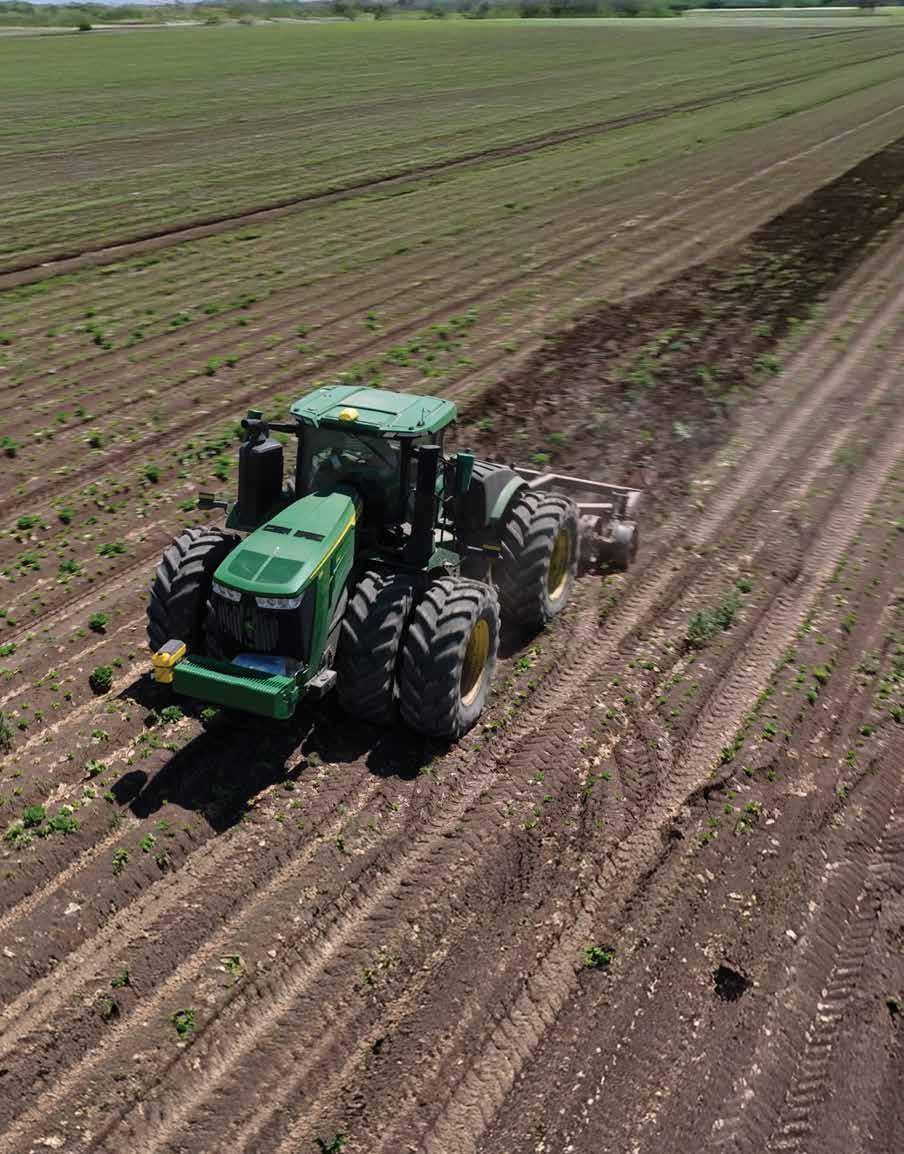






Welcome to the 8th annual edition of Valley Agribusiness. We are thrilled to provide you with a bumper crop of facts, feature stories, and more than a few surprises fresh from the fields of the Imperial Valley, an extraordinarily important desert-growing region.
Rarely will you find an agricultural area as expansive, productive, or full of variety as California’s Imperial County. The numbers paint a striking picture. According to the state’s most recent data, Imperial County’s ag production value ranks 8th out of the state’s 58 counties – and mind you, this is the state that tops the nation in total ag output value.
Tucked into the southeastern corner of California, Imperial Valley makes up the lion’s share of the desert region, which, thanks to its unique winter produce harvest, is acclaimed for supplying 80 to 90 percent of the nation’s leafy greens and other vegetables during the winter.
Thanks to its year-round growing season, Imperial Valley growers harvest a uniquely broad range of crops and commodities. So it is not a stretch to suggest that if you live and eat … well, just about anywhere, there is a good chance that you’ve benefitted from Imperial Valley agriculture.
Find that hard to swallow? Chew on this: the sugar processed at Spreckels Sugar Co. south of Brawley from the Valley’s thriving sugar beet crop supplies Hershey’s, Nestle, and other major food producers.
How about some savory cheese, or scrumptious ice cream, or a frosty glass of milk? It can’t exist without alfalfa to feed dairy cows. Imperial County leads California
in alfalfa production, according to the most recent data from the California Department of Food and Agriculture.
Beyond taking pride in harvesting the nation’s winter salad bowl, Imperial Valley agriculture is California’s top producer of several commodities, including “seed for planting, veg & vine” and “seed for planting alfalfa.” Much of the seed harvested in the Valley is exported for use throughout the world.
To suggest Imperial County agriculture’s reach spans the globe isn’t a stretch at all. The county Agricultural Commissioner’s Office is required to inspect and issue phytosanitary certificates that certify the commodities being exported are free of pests and diseases of concern. In 2023, the Agricultural Commissioner’s Office issued more than 18,600 certificates for commodities exported to a total of 84 countries. More than 60 percent of those exports went to Mexico, Japan, Korea, Taiwan, and the United Kingdom.
Vegetables, hay, seeds, and fruit comprised most commodities that received phytosanitary certificates from the county in 2023 for export overseas.
Yet, exports are only a fraction of the bounty harvested here. Imperial County growers harvested nearly $2.7 billion in commodities on 578,659 irrigated acres in 2023, according to the county Ag Commissioner’s latest Crop and Livestock Report.
The Valley’s top commodity was cattle in 2023, as it has been for many years. Nearly 300,000 head of cattle were raised during the year. Yet, the local cattle industry was not the star in the livestock category as far
as the state’s 2022-23 statistical report was concerned.
That honor went to the miscellaneous livestock category. According to the state, Imperial Valley produced 50 percent of the state’s miscellaneous livestock, which includes calves, replacement cattle, dairy animals, milk, manure/compost, mixed cattle, sheep, Wagyu cattle, wool, and animal sales at the annual California Mid-Winter Fair auction.
In addition to miscellaneous livestock and seed categories, Imperial County leads the state in producing carrots, sweet corn, Sudan grass, Bermuda grass, and hay. The county is among the state’s top five producers of multiple other commodities.
The stunning number of crops grown here makes local agriculture exceptional. During 2023, Valley growers cultivated more than 70 different crops, according to the Imperial Irrigation District.
That cropping diversity provides protection for the local agricultural economy from inevitable unanticipated economic shocks. That was the conclusion of a comprehensive economic analysis of Imperial County agriculture, called Crop Report Plus, released in 2024. The report determined Imperial County’s agricultural sector boasts the highest level of economic diversification in California.
In this edition, you will have a chance to feast on a bounty of information and stories about this unique agricultural region. While the data paints a fascinating picture, it is the people you will have a chance to read about who make Imperial Valley agriculture shine.
We hope you will enjoy it all. n
EDITORS & PUBLISHERS
Bill Gay
Sue Gay
Susan Giller
Bill Amidon
CONTRIBUTING EDITOR
Darren Simon
CONTRIBUTORS
Caitlin Chavez
Bill Gay
Susan Giller
Sandra Mendivil
Blake Nelson
Darren Simon
COVER PHOTO
Joselito N. Villero
GRAPHIC DESIGNER S
Alejandra Noriega
Alejandra Pereida
PHOTOGRAPHERS
Bill Amidon
Joselito N. Villero
Imperial County Agricultural Commissioner's Office
WEB DESIGNER S
Jesus Uriarte
Sergio Uriarte
SALES
Bill Amidon
John Lovecchio
ADVERTISING
bill.amidon@reliancepr.com 760-693-5330
SUBSCRIPTIONS
(Includes Valley Agribusiness and quarterly Imperial Valley Alive!)
Send name address and email address with $21.70, includes tax, to:
Reliance Public Relations, Inc.
P.O. Box 1944 • El Centro, CA 9224 4
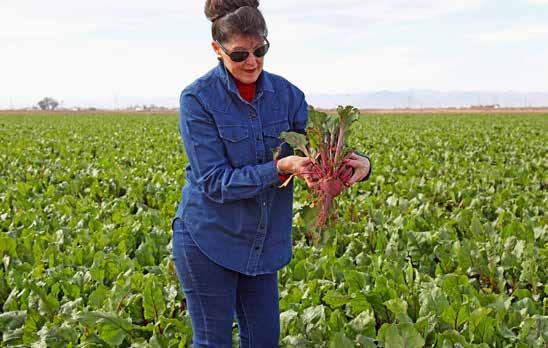
6 DRONE TECH: AN EMERGING TOOL IN PROTECTING CROPS
8 VEGETABLES BY THE NUMBERS
12 21ST CENTURY ECONOMIC MODELING PROVES IMPORTANCE OF IMPERIAL COUNTY AG
14 PAULA MCCONNELL PANGLE: NEW I.C. FARM BUREAU PRESIDENT HAS A CLEAR MISSION
16 MARK MCBROOM NAMED FARMER OF THE YEAR
18 IID: SAVING WATER AND FORGING PARTNERSHIPS ON THE COLORADO
22 SUGAR BEETS: LOCAL GROWERS EXPAND ACREAGE AMID STEADY MARKET
24 INSPECTING TO PROTECT LANDSCAPING, CROPS
26 DOC'S DATES FINDING INNOVATIVE WAYS TO REACH CUSTOMERS
28 FRANK MIRANDA A MENTOR AS MUCH AS A 'FRIEND OF THE FARMER'
29 LIVESTOCK CONTINUES AS VALLEY'S TOP COMMODITY
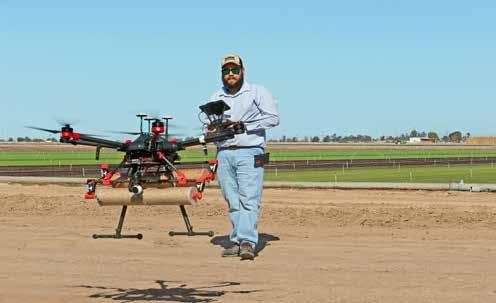



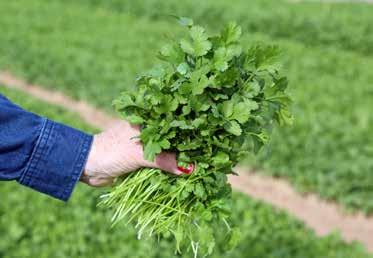






By Darren Simon
In a celery field east of El Centro one quiet winter morning, a sixpropeller drone navigates about 25 feet overhead, following a precise flight path above a 12.5-acre spread, dropping its nearly invisible cargo.
That cargo is precious to pest control advisors and growers. It contains hundreds of thousands of eggs that will hatch into predatory green lacewings. Lacewings are described simply as good bugs that devour bad bugs, like tiny aphids, that threaten crop health.
Thanks to drone technology, those good bugs are being distributed as a biocontrol agent in a more uniform way than might otherwise be done by hand. It allows the lacewings to have a greater impact.
To that end, drones have become an emerging tool sought by pest control advisors and growers in the region. They are an added line of defense, both for their efficiency in fighting pests and for their
ability to provide critical field imaging to spot problems.
“The goal is to protect that crop and to make sure it can produce the highest quality yield at the lowest possible cost,” said Brawley native Curtis Pate. His agronomy company, Agtegrity, introduced the use of drones to aid local crops in the Valley as well as Coachella and Yuma.
A licensed pest control advisor (PCA) and certified crop advisor, Pate, whose company is based in Yuma but has an office in Brawley, began Agtegrity as an agronomy consulting firm in 2012. He added drone service to his operation initially for field imaging in 2014. The biocontrol service was added in 2018.
The biocontrol component came through a contract with a Central California company, Parabug, founded by Salinasbased PCA, Chandler Bennett. Bennett patented the use of drone technology to deliver beneficial insects.
“He learned of the work I was already doing in this region,” Pate said. “We met and put together an agreement that we would
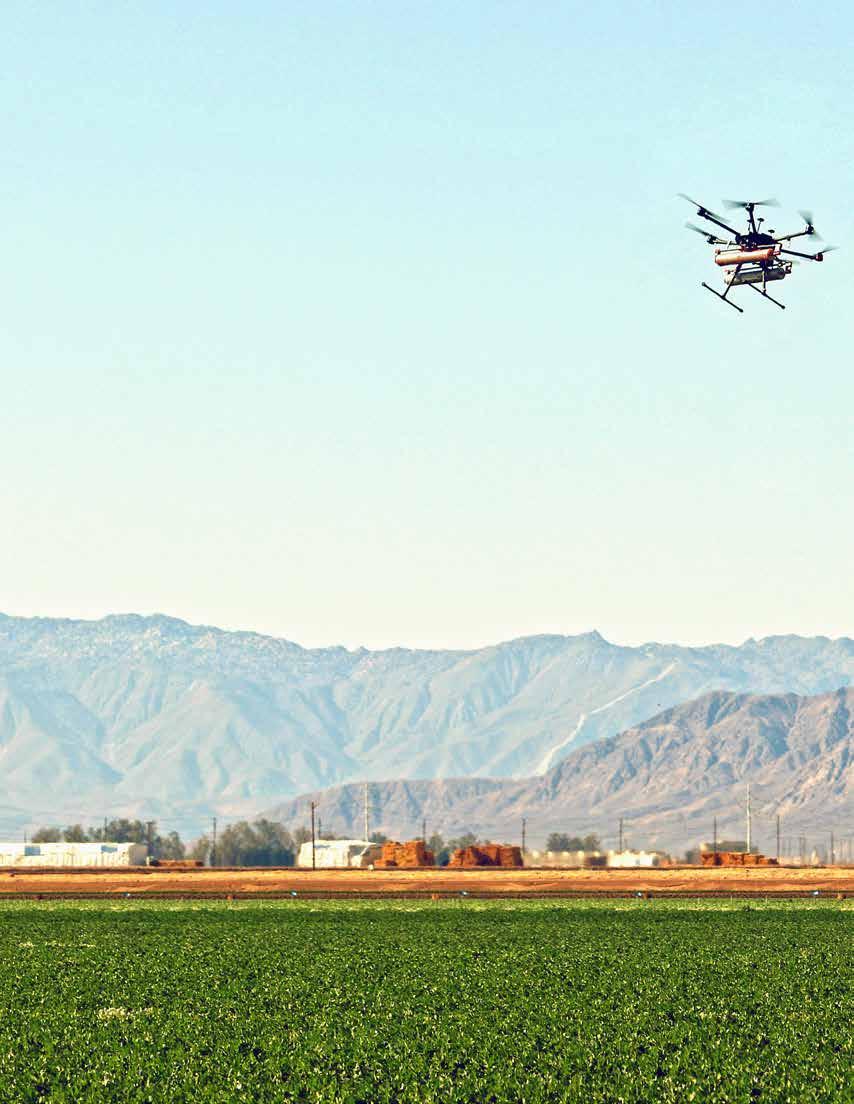
be their agent in the desert.”
Together with his drone pilot, Jason Fifield of Brawley, Pate’s drone service has become an increasingly important tool for growers and PCAs. It’s the PCA’s job to determine the best control agent for the fields they are contracted to monitor. Typically it is the PCA who will reach out to Agtegrity if they determine a drone application will work best.
While the delivery of beneficial insects via drone can work on all fields, its primary use in the Valley has been for long-term organic vegetable crops, such as celery and cabbage. More recently, the drones have also been used in date and citrus orchards.
Local pest control advisors said the drones are making a difference, in particular, in delivering beneficial insects on taller crops
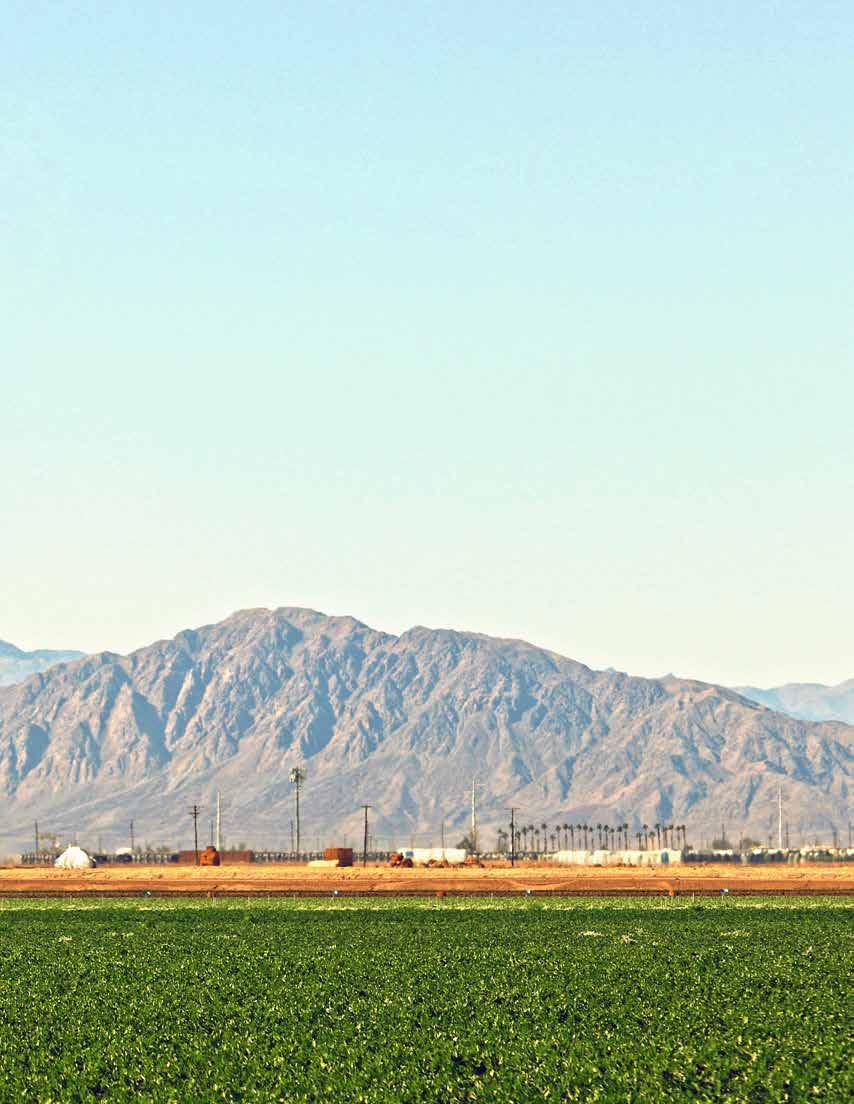
BELOW: Agtegrity owner Curtis Pate on site at a local field.
- Photos by Joselito N. Villero
with thick canopies, like celery, where biocontrol agent deliveries can be more difficult.
“With drone applications, I can get a population of the good bugs in there to kill the bad bugs, creating a good environment within that tall and thick canopy,” said Brett Thomason, a licensed PCA and crop advisor based in El Centro.
He added, “The drone releases in a very uniform way. It enhances efficiency and improves accuracy. From a pest control advisor point of view, it provides a peace of mind that I am going to get a better release of that biocontrol agent.”
Local grower Scott Howington, at the time of this story, was gearing up to use drone delivery of lacewings on a Valley farm operation that he works with as a consultant, Lakeside Organic Farms. It will be the first time in 15 years that he has used this kind of biocontrol delivery.
He said in the past, he tried to use beneficial bugs on his organic fields but stopped because hand delivery of the good bugs didn’t wipe out the aphids. Since then, he has relied on organic pesticides, which haven’t always been successful.
He thinks the drones will make a difference. “I’m really excited to see what kind of distribution we will see with the drones and whether we’ll have better control,” he said. “I think we will.”
The beneficial releases via drone work by having a precise
CONTINUED ON PAGE 30

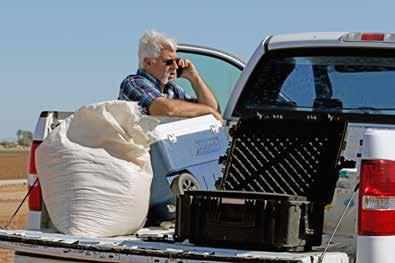


By Susan Giller
Imperial Valley has long lauded that produce grown here supplies the nation with about 80 percent of its winter vegetables, making the desert southwest the nation’s Winter Salad Bowl.
So, alarm bells went off in the Imperial Valley when a series of videos on the Yuma Fresh Vegetables website titled “Yuma – the Winter Salad Bowl” aired and then became part of a social media marketing blitz. In one video, George Frisvold, Ph.D., an agricultural economist with the University of Arizona, is filmed stating, “Yuma is to ag, what Detroit is to cars…”
“I’m hearing it so often now that it’s becoming incredibly frustrating,” said Shelby Trimm, executive director of the Imperial Valley Vegetable Growers Association (IVVGA). “It’s not about competition—it’s about accuracy. We take immense pride in the role the Imperial Valley plays in feeding the nation, and it’s disheartening to see misleading claims that diminish the collective effort of both regions.”
Trimm emphasized the importance of recognizing the shared contributions of Imperial Valley and Yuma in supplying winter vegetables. “Regardless of who
claims to grow more, the reality is that together, we do an incredible job feeding the nation. Our growers are committed to producing safe, high-quality food, and that’s what truly matters.”
Both Imperial and Yuma counties have good reason to be proud of the bounty of leafy greens and other produce their growers harvest each winter. Each region is also justifiably proud of its water efficiency and use of technology to improve its crops. However, is either Yuma’s or the Imperial Valley’s winter produce harvest so large it dwarfs all others?
The answer is no. However, together, the Imperial Valley and Yuma fill the nation’s Winter Salad Bowl, as is explained in a video posted by the California Department of Agriculture two years ago that features Jack Vessey, a fourth-generation Holtville farmer and a former IVVGA president. Vessey describes the desert southwest as the Imperial Valley, Yuma, and even Mexicali and then states, “We basically provide the United States with their leafy green supply in the winter months.”
And it turns out that the importance of the Imperial Valley’s and Yuma's vegetable harvests in the nation’s food supply overflows the salad bowl analogy. In fact, each region is among the top
three vegetable producers in the nation. However, ferreting out that information isn’t easy, both because of the similarities and differences between the Imperial Valley and Yuma.
Both regions share the advantage of the desert southwest’s climate that makes yearround growing possible and profitable. This unique climate enables growers in both regions to plant, harvest, and ship to market winter produce in the sweet spot when virtually no other region in the county can.
And, growers in both the Imperial Valley and Yuma harvest and ship a wide array of leafy greens and other vegetables to market.
The two powerhouse growing areas rely on the Colorado River for irrigation water. Yet, they are divided by the river, which forms the boundary between California and Arizona. That is where glaring differences in available data emerge. Finding accurate, comparable data between Imperial Valley and Yuma can be challenging due to differences in state reporting requirements.
California requires county Agricultural Commissioners in all 58 counties to compile detailed crop information each year, which the state then compiles into the annual “California Agricultural Statistics Report.”
Both the counties’ and California’s
reports are rich with detailed information about specific commodities that provide a comprehensive picture of agriculture in each of the 58 counties and where it ranks in the state’s total agricultural output.
For California, the top agricultureproducing state in the nation, the numbers and details are crucial for its economy.
Neither Arizona nor Yuma County maintains similar data.
Fortunately, the U.S. Department of Agriculture’s (USDA) National Agricultural Statistics Service (NASS) publishes a Census of Agriculture in the U.S. every five years. The census includes data for each state and detailed County Profiles as of 2022. The most recent census released in 2024 provided a way to avoid “applesto-oranges” or, more appropriately, “cantaloupes-to-cauliflowers” comparisons between Imperial Valley and Yuma.
The Census of Agriculture reporting categories and results differ somewhat from how data is quantified in the California Agricultural Statistics Report. However, the standard data sets included in the Census County Profiles proved extremely helpful and illuminating in the comparison between Imperial Valley and Yuma.
Imperial County’s total crop output, excluding livestock, poultry, and products, ranks sixth in California and sixth among the 3,074 crop-producing counties in the nation, according to the Census of Agriculture.
Yuma is the top producer of crops in Arizona and number 13 in the nation, according to the Census.
Imperial County has much more acreage in production than Yuma, which is reflected in the market value of each region’s total ag sales. According to the Census profiles, Imperial County’s total market value of agricultural products sold is $3.04 billion, compared to Yuma’s $1.5 billion.
However, when it comes to vegetables, the two regions become more similar. The Census provides detailed data for various crop types, including “Vegetables, melons, potatoes, sweet potatoes.” Yuma’s product sales are listed at $1,129,444,000 for the vegetable category, compared to Imperial Valley’s total sales of $1,219,515,000.
According to the Census of Agriculture, Imperial County ranks second in California for total vegetable market value, behind only Monterey County, which is home to the Salinas Valley. Imperial County also placed second in the nation for produce value sales among the nation’s 2,831 vegetablegrowing counties. Only Monterey County has higher vegetable values.
The Census ranks Yuma’s total vegetable sales as the highest of Arizona’s 15 vegetable-producing counties and third in the nation, behind Monterey and Imperial counties.
The salad bowl provides a simple and effective marketing tool—even Monterey County touts itself as the World’s Salad
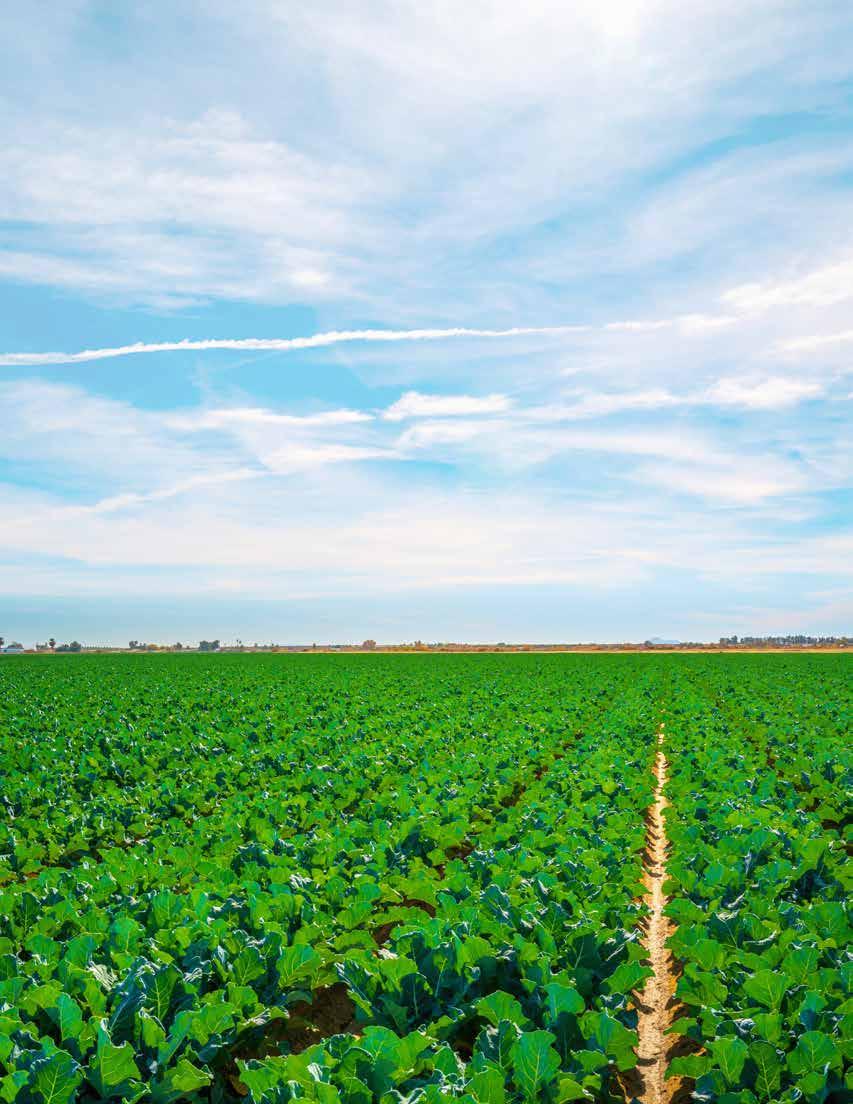
Bowl. Yet, the image falls short of portraying the depth of dedication and work Imperial Valley growers put into improving the produce they grow.
“The goal of our members is to provide our nation with the safest, freshest, most nutritious fruits and vegetables,” said Trimm of IVVGA members. “Food safety is of the utmost importance and our top priority.”
For instance, Brawley grower and IVVGA member Larry Cox was among the first growers in California to participate in developing what is now known as the comprehensive Leafy Green Marketing Agreement (LGMA) food safety program that was created following the first E. Coli outbreak in the state to ensure produce would be safe. He remains on the state advisory board.
Like Cox, many IVVGA members devote time to such issues of key importance as food safety, water conservation, environmental protection, and public education.
Trimm said that food safety never stops being the priority of IVVGA members.
“Ensuring that consumers receive the safest, freshest, and most nutritious produce isn’t a one-time achievement— it’s an ongoing commitment,’ she said. “Every produce season presents new challenges, and our growers are constantly refining and adapting their practices to ensure we meet the highest standards in food production.” n
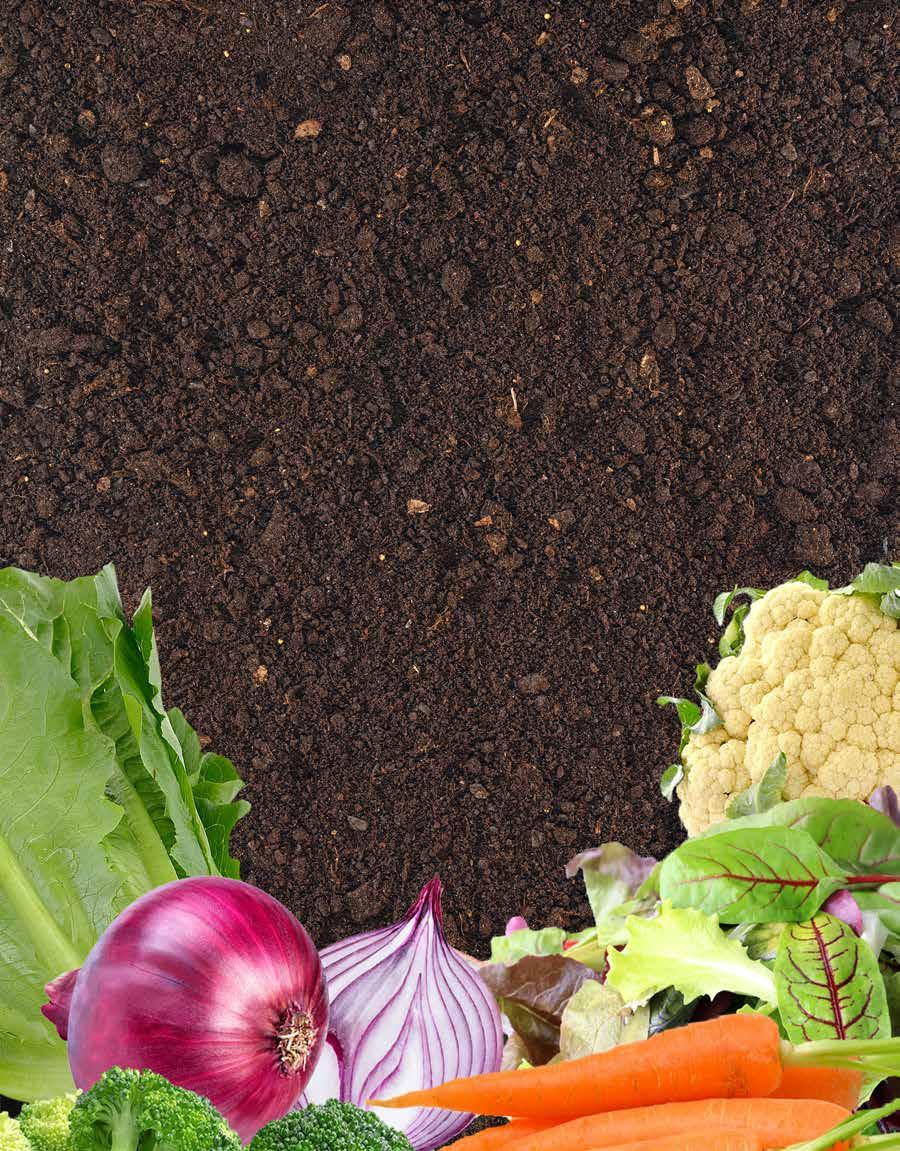






By Bill Gay
Imperial County agriculture, for the first time, pumped more than $5 billion into the local economy, according to the county’s third Crop Report Plus released in June. That total reflects nearly a 17 percent increase from the previous economic analysis done in 2021.
The report also underscores the local industry’s resilience in the face of global and regional challenges, including the COVID-19 pandemic. It concludes that Imperial County’s agricultural sector boasts the highest level of economic diversification in California.
The economic analysis is based on 2022 data. County Agricultural Commissioner Jolene Dessert noted the report again highlights the dominance of agriculture in the Valley in terms of direct and indirect impacts on economic output and employment.
The study supplements the county’s annual agricultural report. “Instead of stopping at farm production values,” Dessert said, “it also quantifies local food processing, employment, and economic ripple effects.”
The comprehensive analysis authored by Jeff Langholz and Fernando DePaolis of Agricultural Impact Associates shed light on agriculture’s multifaceted contributions.
The firm specializes in agricultural economics, providing data-driven insights to guide policy and decision-making.
Langholz noted in his presentation of the report in July that it “captures the greater value of agriculture.” He told the Board of Supervisors in his presentation, “It remains a golden nugget for Imperial County.”
Several key elements stood out in the 2024 Crop Report Plus, which runs agriculture data through economic models to show broader economic contributions.
Including production, processing, and multiplier effects, agriculture added $5.095 billion to the local economy in 2022. The total equates to nearly $14 million per day or more than $580,000 per hour.
Of the total, $3.681 billion stemmed from direct economic output of production and processing, while $1.415 billion came from multiplier effects, including supply chain purchases and employee spending.
Agriculture supported 19,812 jobs, with 14,537 in production and processing— accounting for 17 percent of all employment in Imperial County—and 5,275 jobs created through ancillary activities.
Agriculture retained its position as the county’s largest industry and secondlargest employer.
The $1.415 billion encompasses the direct purchases made by agriculture companies and the spending by their employees,
suppliers, and related industries. These ripple effects sustain a wide range of businesses, from equipment suppliers to local retailers.
“This reminds us what a powerful engine agriculture is for the Imperial County economy,” Langholz said.
Imperial County’s agricultural output spans a wide array of products. This diversity acts as a buffer against economic shocks.
“So many other counties have become dependent on a small number of commodities, which makes them more vulnerable to recessions, pandemics, and other economic shocks,” Langholz said, adding Imperial County’s diversified portfolio provided critical stability even during the pandemic.
“The pandemic disrupted supply chains, farm labor, production costs, exports, prices, and other factors,” Langholz said. While 16 Imperial County commodities declined in value in 2020, they were offset by sweet corn, cantaloupes, and 24 other crops that experienced significant growth. That growth resulted in an overall .5 percent gain in the pandemic year.
“The most noteworthy differences between the three reports were not what changed, but what didn’t change. Imperial County agriculture not only continues to CONTINUED

















By Darren Simon
When it comes to advocating for Imperial Valley agriculture, grower, and farm owner Paula McConnell Pangle believes a strong voice is needed and that the Imperial County Farm Bureau can be that voice in partnership with others.
She also believes that it doesn’t matter
whether those strong voices are male or female as long as they are heard and action is taken.
For that reason, she places little importance on the fact she is the first woman in the history of the Imperial County Farm Bureau to serve as president, having been recently elected to that leadership role.
Still, this first is just another step in a 50year agricultural career in which she has been a groundbreaker more than once.
“Being the first woman to serve as president of my local county Farm Bureau is an honor that reflects my deep-rooted passion for agriculture,” Pangle said.
It’s a passion instilled in her by her parents,
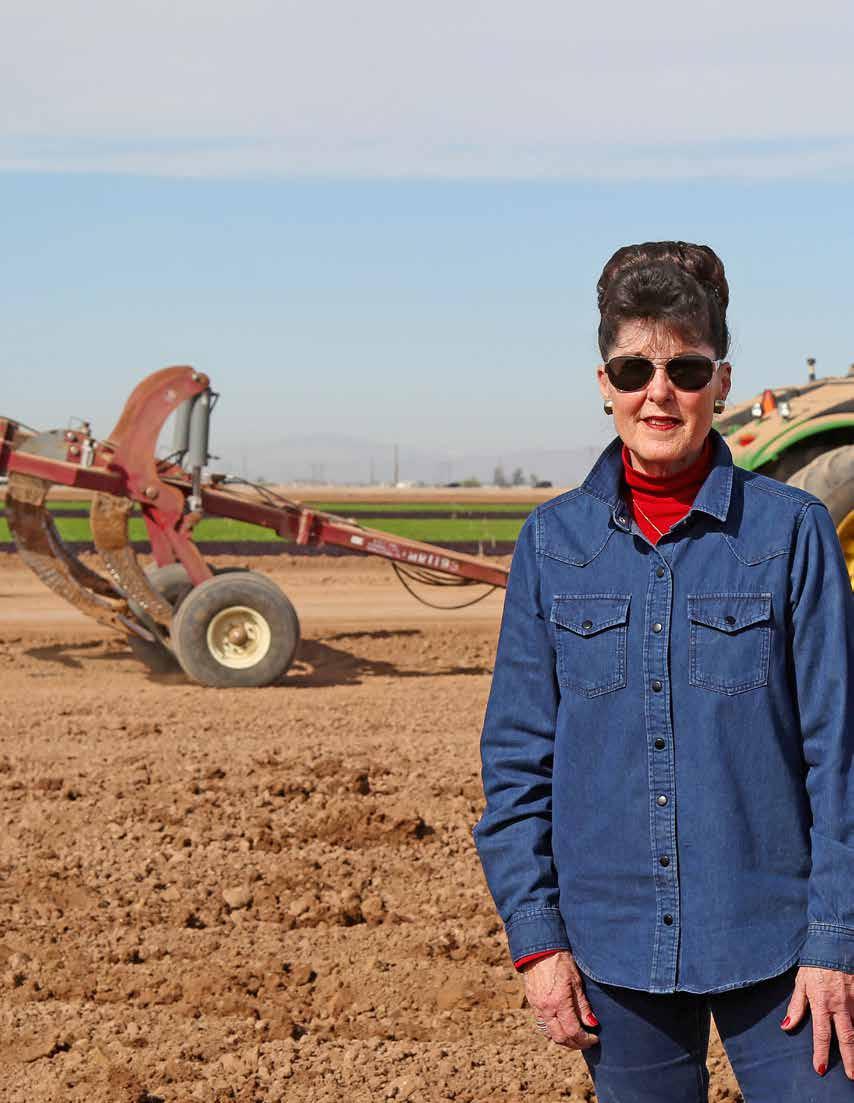
“I learned firsthand the importance of hard work, perseverance, and advocating for local agriculture from both my parents.”
-Paula McConnell Pangle
the late Jack and Pauline McConnell, both of whom, Pangle said, devoted their lives to McConnell Ranch, east of El Centro, and the success of agriculture Valleywide.
“I learned firsthand the importance of hard work, perseverance, and advocating for local agriculture from both my parents,” she said. “I also learned from them that while men and women may sometimes
approach challenges differently, what truly matters in agriculture advocacy is our shared commitment to supporting farmers and ranchers and strengthening our agricultural communities.”
Pangle has a clear mission in her role as Farm Bureau president—to advocate for and protect the local agriculture industry and to help navigate such challenges as water and regulatory issues.
She also wants to build unity within Imperial County by working with the Imperial Irrigation
District, the county Board of Supervisors, the county Agricultural Commissioner’s Office, and such others as the University of California Desert Research and Extension Center, law enforcement, schools, and 4-H and Future Farmers of America programs.
“We are better together, we are stronger, and we can accomplish more,” she said.
She added the Farm Bureau is in a position to lead advocacy efforts, thanks to its executive director, Rachel Magos, and her team, as well as the Farm Bureau’s Board of Directors and executive committee. She also credited the work of those in the Young Farmers and Ranchers program.
“We’re a team dedicating countless hours to committees and issues to make agriculture better and lasting for future generations,” Pangle said.
Pangle brings to her Farm Bureau presidency a career of advocating for agriculture, facing challenges, and
CONTINUED ON PAGE 34
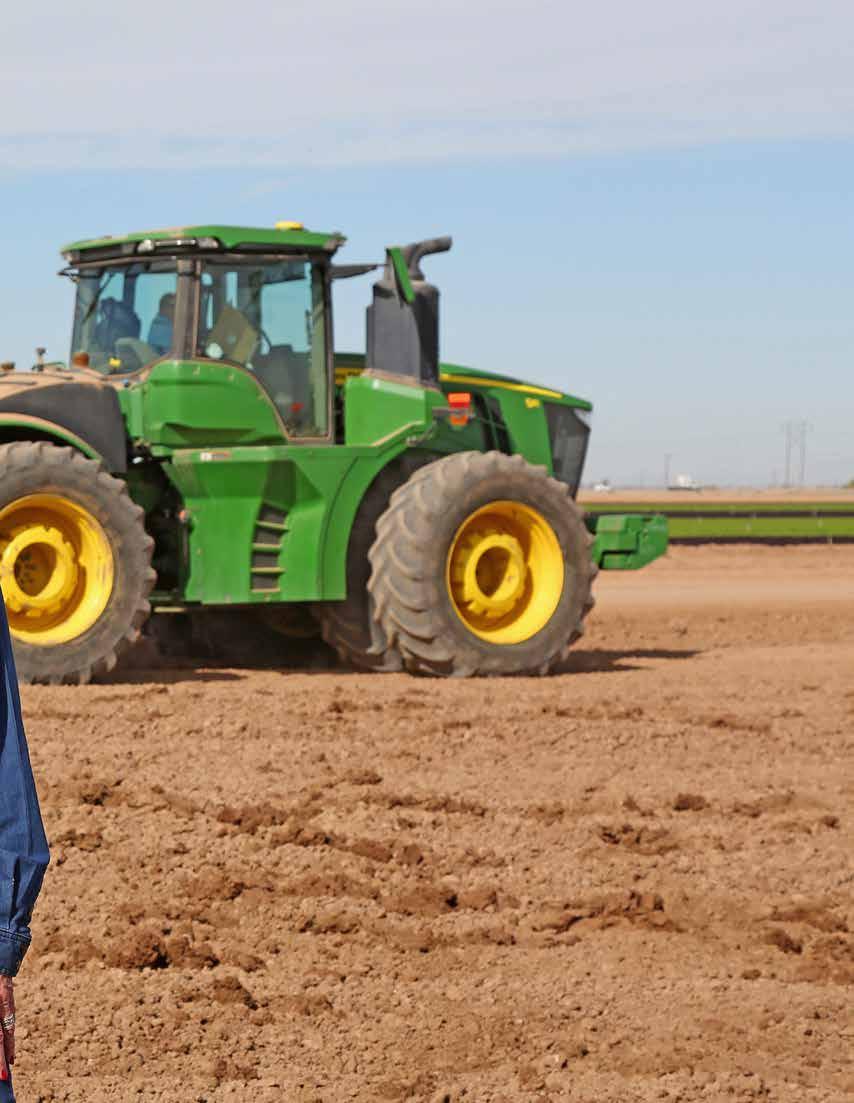



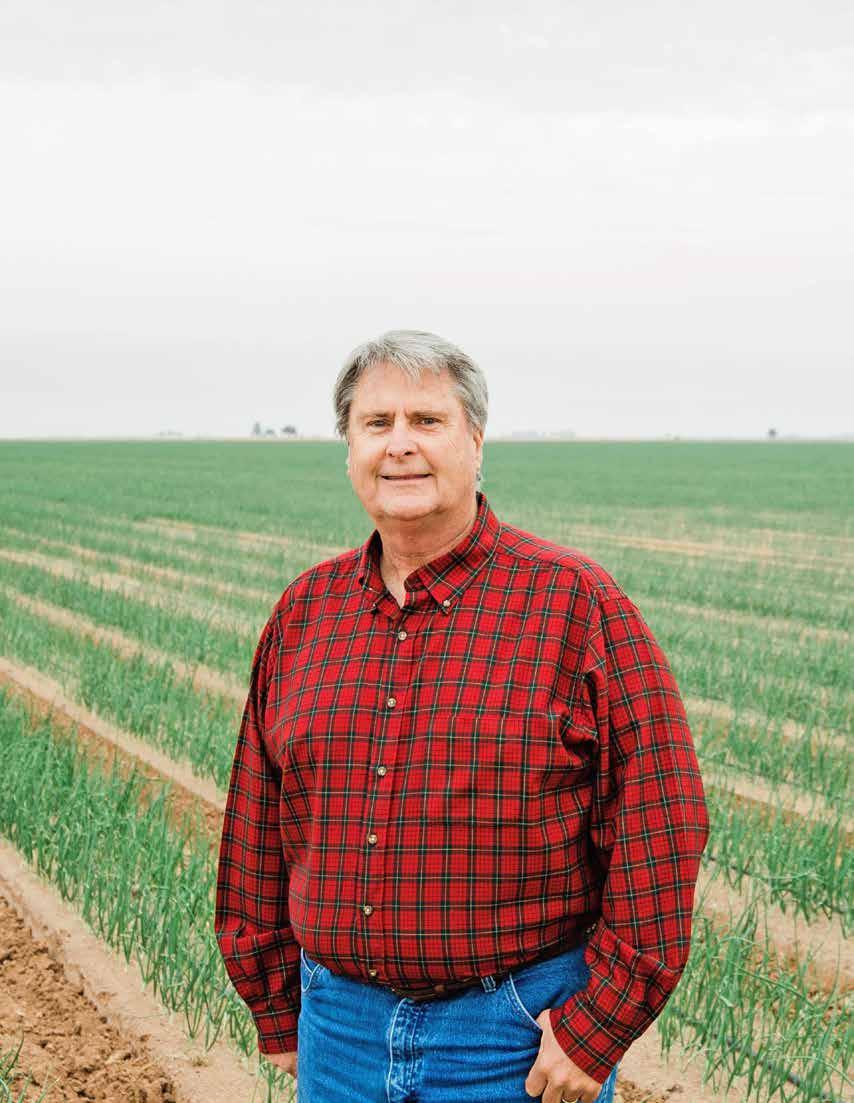
By Blake Nelson
Mark McBroom attended the 2024 Imperial County Farm Bureau annual meeting to celebrate another year of agriculture, community, and colleagues as eager as the rest of the attendees to see who would receive the year’s top honor: the Jim Kuhn Memorial Farmer of the Year award.
Then he saw pictures of his own farms and ranch appear on the screen, and tears began to flow.
“My son was sitting beside me when I
figured it out,” McBroom said. “Next thing I knew, my daughter and grandchildren were standing behind me. It was emotional.”
The Imperial County Farm Bureau created the Farmer of the Year award in honor of the late Jim Kuhn, a farm leader in the Valley, who died in a traffic accident
in 2005. The award recognizes recipients for their contribution to the agriculture community through innovation, promotion of agricultural education, and involvement in the agriculture community, as well as their overall involvement and contribution to the Imperial Valley.
“Mark McBroom is a true leader and advocate for Imperial Valley, which shows through his tireless work, innovative contributions to the agriculture industry, and immense generosity to our community,” said Rachel Magos, Imperial County Farm Bureau executive director.

McBroom was named the 19th winner of the award in recognition of his leadership in citrus and broader agricultural industries, his dedication to protecting and promoting Valley agriculture, his philanthropy, and his devotion to his family, faith, and work.
Elected officials and leaders of state and regional public agencies also heaped on praise for McBroom.
“I was humbled that a group of my peers and folks I admire thought enough of me to deserve this recognition,” he
said. “I choose to invest my time in things that will help everyone. If I can share my experiences working with the best farmers in the valley, that’s what is important to me.”
McBroom, who was born in Brawley to David and Joy McBroom, has agriculture in his blood. He grew up assisting his dad and grandfather with McBroom Hay, where he learned the value of a strong work ethic. His mother was a homemaker who valued
CONTINUED ON PAGE 38




By the Imperial Irrigation District
Just a few months ago, in December 2024, the efforts of Imperial Valley growers, the Imperial Irrigation District, and California’s Colorado River contractors were recognized for voluntarily conserving more than 1.2 million acre-feet of water in just two years.
It’s a rate that was faster than expected. By working together, the conserved water was left in Lake Mead, the nation’s largest reservoir, to help stabilize and protect critical reservoir elevations after more than two decades of historic drought conditions.
This volume of conserved water is a result of the successful implementation of federally funded System Conservation Implementation Agreements (SCIA) in 2023 and 2024, as well as Intentionally Created Surplus conservation stored in Lake Mead, and led to historically low California Colorado River diversions those years.
These developments come at an imperative time and are the result of much hard work, negotiation, and cooperation across the Lower Colorado River Basin to support the river, Imperial Valley’s only water source.
Further, this new conservation is occurring more than 20 years into the Quantification Settlement Agreement, the nation’s largest ag-to-urban water conservation and transfer agreement. Coming up with additional conserved water, on top of that already being conserved annually by IID, has been a challenge during this time of severe drought in the Colorado River Basin, yet no one has been more committed than IV growers.
Local farmers and IID have, since 2003, conserved over 8.425 million acre-feet to provide water supply resiliency to Southern California and the Colorado River Basin. Prior to the system conservation water, IID agreed to conserve through the federal SCIA, the district had been conserving and transferring about 500,000 or more acre-

Shields, IID Water Department Manager
feet a year.
In August 2024, before the December news announcing the 1.2 million acre-feet California conservation milestone, the IID Board approved a second, multi-year conservation agreement with the federal government to leave up to 700,000 acrefeet of water in Lake Mead through 2026, the largest single SCIA funded by Reclamation.
The Board’s approval of the SCIA provides for the implementation of three years of additional conservation programs, from 2024 through 2026. It targets the creation of about 250,000 acre-feet a year of Imperial Valley system conservation water that will remain in Lake Mead to aid the droughtstricken Colorado River (boosting IID’s total four-year contribution to more than 800,000 acre-feet, or 11 feet of elevation, to Lake Mead).
IID’s conservation was generated by an expansion to IID’s On-Farm Efficiency Conservation Program and a newly developed Deficit Irrigation Program.
Further, the district’s water conservation
commitment unlocked up to $250 million in federal funding to accelerate Salton Sea Restoration projects.
Through IID’s dedication to conservation and its never-ending advocacy for the Salton Sea, it’s taken a long time to get to this point, and the 2007 Colorado River operating guidelines expire next year. A whole new set of post-2026 guidelines are still under negotiation for the decades ahead.
So, what’s next? We’ve asked Tina Shields, one of IID’s Water Managers, to speak about the road ahead:
IID will do whatever it takes to protect its water rights and support our local community and water users, Shields told DC-based Irrigation Leader magazine, which just published an interview with her.
IID leaned into its partnerships and tried to build on them, expanding collaborations through intrastate and lower basin alliances to develop near-term voluntary compensated conservation drought plans that resulted in the SCIAs. These then allowed the focus to be on the more critical post-2026 issues, she said.
IID has recognized that if there is no water in the system, its exceptional water rights alone can’t serve our customers.
So, we need to find ways to expand the established partnerships within California to provide long-term resiliency for our water users to model for the other states the opportunities as they may have to overcome similar challenges through these once-unlikely alliances.
We will have tough issues to resolve, but California is much further along than other states in finding a path forward and building on existing agreements and partnerships.
In addition to the challenges that come with increased conservation goals and rising regulatory requirements, and tasked at the same time with delivering the water needed to grow more crops to meet the

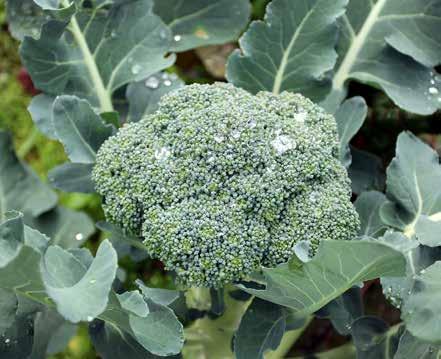
Protecting the valley’s water rights and energy balancing authority while maintaining affordable rates and providing the highest level of customer service.
A century of service.

1
2
7
nation’s food demands, the district is also faced with upgrading its 113-year-old water delivery system.
IID is working to outline and prioritize its longer-term infrastructure investments that will be necessary to maintain the same level of service or better. We see a need for additional technology and operational flexibility to support customers and future generations of growers.
The District will always stand behind its water rights, but it also has to look ahead to consider how best to adapt to a changing future and develop solutions that contribute to the longer-term viability of its only source of water: the Colorado River.
We also need to find more effective ways to remind the public of where its food supply comes from.
At the end of the day, we all have to eat–
including urban water users–and a safe and reliable food supply depends on the producers we serve and the agricultural water supplies we deliver.

Excerpts included in the article were used with permission from the Irrigation Leader magazine. To read the full interview with Shields, visit: http://bit.ly/4bOdZ5I n

By Darren Simon
When it comes to California’s sugar beet crop, the Imperial Valley is the center of production.
It grows nearly all of the state’s acreage, spurred on by the relationship between growers and the Spreckels Sugar plant in Imperial, which is the state’s last remaining sugar production facility.
This growing season, driven by market conditions and a desire to push the sugar plant’s limits, Spreckels decided to expand production. That meant the company needed growers to agree to plant even more than the 23,000 acres they have done on average per year.
All 45 Imperial Valley sugar beet growers agreed to the proposal.
As part of the 2024-25 growing and harvesting season, each grower increased their acreage by 20 percent, expanding the Valley’s total sugar beet acreage to 28,000
acres. That growth will increase Spreckels’ sugar production to 352 million pounds in 2025—up from 320 million pounds in years past.
“We are taking a calculated risk because we know we can do it,” said Roger Colmenero, ag manager at the Spreckels plant. “The sugar market has been pretty stable, so that was what we considered. If the market were volatile, it would be too much of a risk.”
Given that the sugar produced by Spreckels serves such major companies as Coca-Cola, Nestle, Hershey’s, and Mars Bars, to name a few, both Spreckels and local growers are confident in their decision.
“Yes, there was risk, but it’s worth it,” said Charles Layaye of Layaye Farms in Calipatria. Layaye also serves as president of the California Beet Growers Association (CBGA), which oversees and advocates for the state’s beet production. “Now, we’ll see how the plant performs.”
Increasing beet acreage requires growers to make changes that could add expenses.
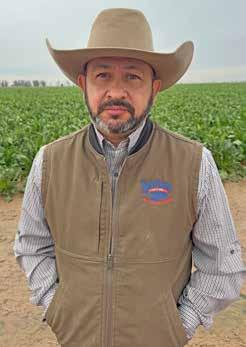
Typically, planting starts in September. Beets are harvested from April to July before the heat harms the sugar beet plants. To harvest the expanded acreage, farmers need to start harvesting early. Ultimately, the CBGA had to approve the change. The association approved starting the harvest three weeks earlier, in the middle of March.
“The growers were willing to supply more for the (processing) plant,” said Curt Rutherford, a sugar beet grower from Brawley, who serves as CBGA’s representative to the national sugar beet advocacy organization–the American Sugar Beet Growers Association. “The sugar beet crop is a good one for the Imperial Valley, and we want to keep it that way, and that means keeping the plant going.”
Increasing beet production is just another step in a historic relationship between the growers and Spreckels.
The beet processing plant is located near the geographic center of the Valley along the Highway 86 corridor between Brawley and Imperial. It opened in 1947 as Holly Sugar to help drive the already growing sugar
beet industry in the Valley and elsewhere in the state.
Now operating as a subsidiary of the Southern Minnesota Beet Sugar Cooperative, Spreckels plays a pivotal role in the nation’s sugar production. Spreckels produces sugar after production in the Northern states ends for the season.
“We are producing in the winter and into the spring when they are getting done,” Colmenero said. “We are the most southern producer of sugar in the nation. We fill an important gap in the sugar production from the Northern states.”
In the unique symbiotic relationship between local growers and Spreckels, everything harvested in a day is what is processed in a day at the plant. The sugar beet crop is one of the few in the Valley where the entire
process, from planting to harvesting to producing and shipping, all occurs locally. Further, every bit of the sugar beet is used. For instance, the pulp from sugar beet is used in feed made for the dairy industry. The plant also produces molasses and other byproducts of the sugar production process.
The sugar beet is considered a field crop. In 2023, the most recent year for which data is available, Imperial County’s sugar beet crop was valued at $53.6 million.
Colmenero said the decision to expand sugar production was largely based on an effort to generate more sugar for market.
“This was not needed to keep the plant in operation,” Colmenero said. “We’re just

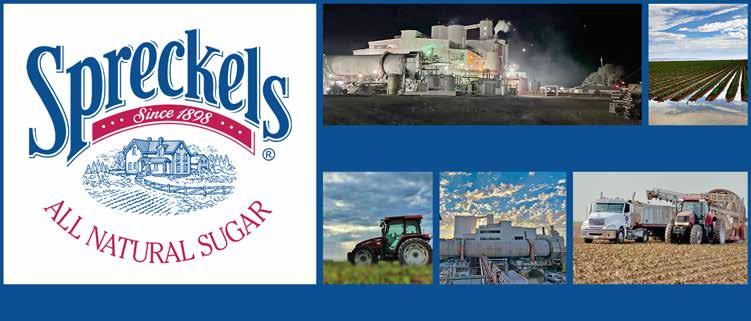

By Sandra Mendivil Imperial County Agricultural Commissioner Pest Exclusion Deputy
In a region known for its vast agricultural fields, Imperial County is home to a thriving agricultural industry that produces a wide variety of crops, including vegetables, grains, citrus, and hay.
The region’s proximity to the international border, neighboring states and counties, and trade routes makes it
vulnerable to the introduction of invasive pests and plant diseases.
These pests can cause serious damage to crops, landscaping, and ecosystems. Further, the introduction and establishment of invasive pests often result in restrictions on domestic and international exports. In short, invasive pests have the potential to result in significant environmental harm and economic losses. Our office is dedicated to preventing their introduction.
The Agricultural Commissioner’s office has established a robust process of
inspection to prevent the introduction of pests through the movement of plant material. While pests can spread in various ways, nursery stock is a primary vehicle. Without vigilant oversight of the nursery trade, pests can quickly spread into agricultural fields and urban areas, causing widespread damage.
The process of inspecting incoming nursery stock begins wherever it may enter the state. This could include international ports, state border checkpoints, maritime ports, airports, parcel hubs, and distribution
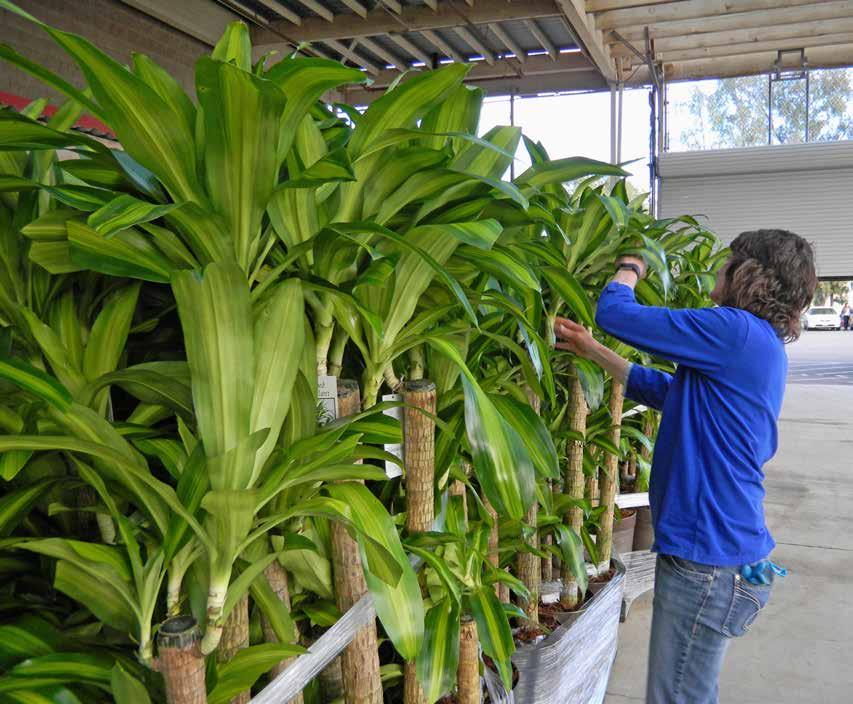
centers. At each of these locations, a network of pest exclusion staff from various county, state, and federal agencies screen plants for pests.
Our staff members are on call to inspect shipments upon entry into the county, wherever they may arrive. Typically, this would be at retail plant nurseries, grocery stores, landscaping projects for businesses or housing developments, and orchards. Our Agricultural Biologists carefully inspect the condition of plants, looking for signs of pests and diseases that may have arrived with the shipment. Part of the inspection process is also to verify the origin of the plants and to review documents assuring compliance with plant quarantines. If a pest is found or a quarantine condition was violated, plants are typically returned to their origin to protect the county from pests.
The impact of invasive pests and diseases can be devastating to farms and also to a community. In urban landscapes, which rely on ornamental plants, trees, and shrubs for aesthetic and environmental benefit, pest infestation can result in the loss of plant life and the costly removal of affected vegetation.
Further, introduced pests can be a serious nuisance. For instance, ants can be introduced through nursery plants, causing stinging injuries, and invading homes. At best, this results in irritation for residents; at worst, it can result in a reliance on costly extermination efforts. Other insects subject to quarantines, like the Asian citrus psyllid and the glassy-winged sharpshooter, can rapidly spread serious plant diseases, threatening entire neighborhoods’ CONTINUED ON PAGE 42



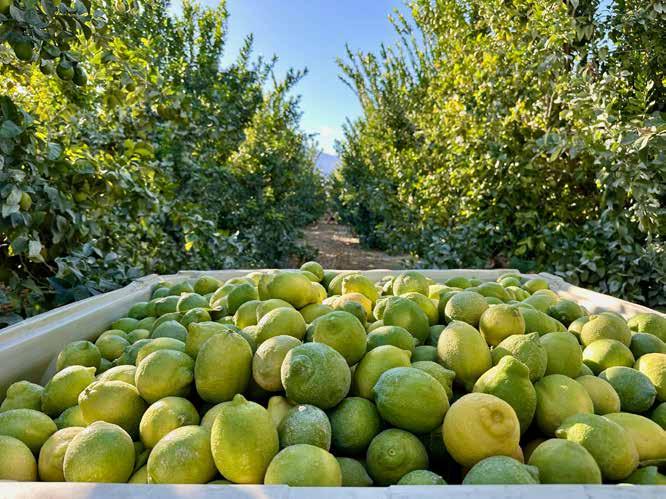


By Darren Simon
With the farm-to-table trend growing nationwide, familyowned P&T Enterprises, which operates the Doc’s Organics packing shed near Westmorland, has chosen an innovative way of directly selling its organic Medjool dates to customers—through Amazon.
As part of the marketing strategy, the farming operation has also generated a new logo on each box of dates to highlight where they are produced. It reads, “Fresh From Imperial Valley California,” over an outline of the state.
“It’s important to have more than one outlet to distribute our dates,” said Gina Dockstader, a partner in P&T Enterprises and Doc’s Organics. Dockstader also chairs the board of directors of the Imperial Irrigation District, the Imperial Valley’s public water and energy provider.
Though a relatively new effort in selling the family’s organically grown dates, marketed as Doc’s Dates, Dockstader said using Amazon could prove a valuable way to reach new customers and spread the word that the Imperial Valley produces its own dates.
P&T Enterprises is not the first Imperial Valley farming operation to market on Amazon. Brandt Beef of Brawley, for instance, sells its Brandt Beef cooking tallow on Amazon. Yet, Amazon remains a unique online tool suited to market commodities with longer shelf lives, like dates.
Imperial County Farm Bureau Executive Director Rachel Magos applauded P&T’s use of Amazon. “Imperial Valley growers are leaders in innovation, including when it comes to marketing their commodities.”
Imperial Valley Vegetable Growers Association Executive

Director Shelby Trimm added, “To remain competitive today, growers have to be innovative in their approach to marketing, and that’s what P&T Enterprises is doing.” While selling online through Amazon or
other online markets cannot work for all crops, both Magos and Trimm think it could be a successful tool for the right kinds of commodities given Amazon’s reach.
For P&T Enterprises, a large family farm in
northern Imperial County, dates make up 275 acres of the operation. The farm also grows 720 acres of citrus and 3,200 acres of field crops. The operation opened its CONTINUED ON PAGE 44
$95,824,000
Misc. Fruit & Nut Crops may include: Grapes, Olives, Oranges, Sweet Limes, Tangelos, Tangerines. Totals do not add due to rounding. * 2022 and 2023 Tangerines were included in Misc. Citrus, Fruit & Nut Crops.

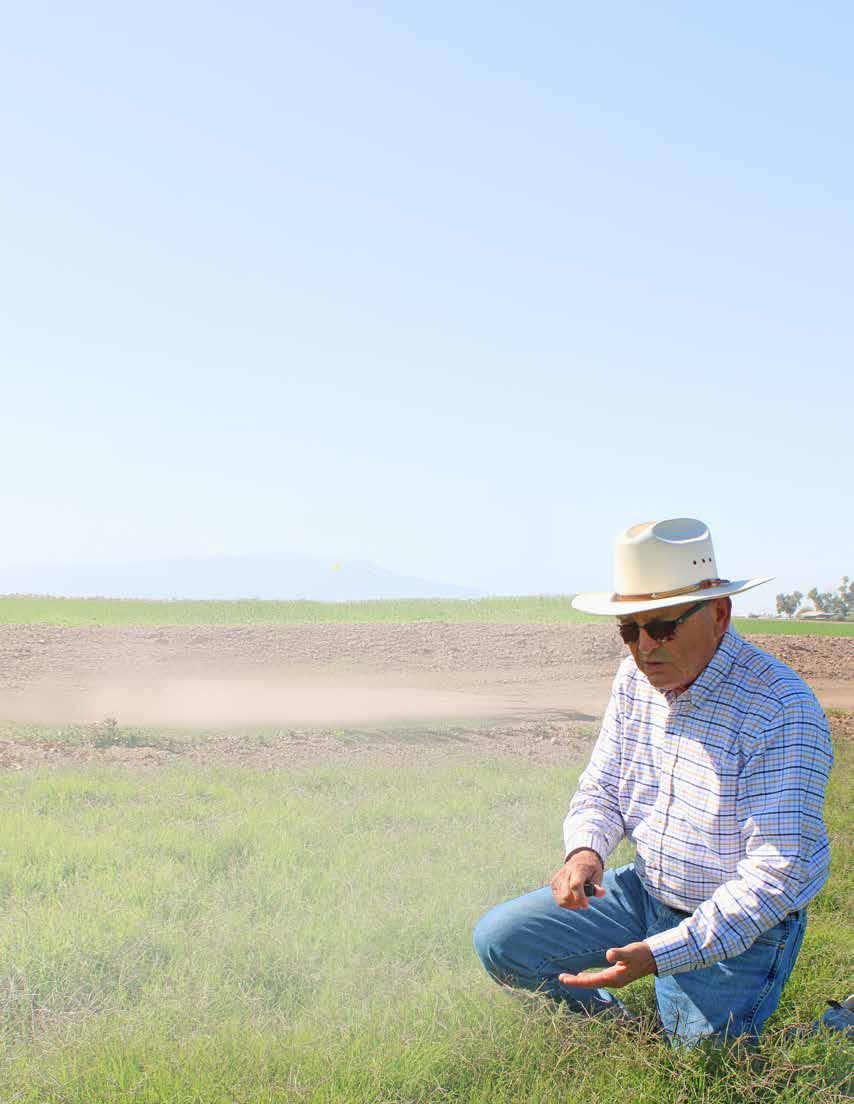
By Caitlin Chavez
Frank Miranda’s calling to serve Imperial County came in childhood as he watched his father contribute to the region’s agricultural industry as a farmworker.
Later, he joined his father in the fields and noticed another worker who worked alone and moved with a slower gait and knelt every few paces to take a closer look at the plants and record observations.
“Seeing this other guy working the fields in a different way, sampling soil and checking the health of plants, gave me the idea that this may be a job I want to do,” said Miranda, who was born and raised in Calexico.
Today, Miranda resides in Holtville with his wife, Emily, having built a career as an agricultural support specialist whose expertise and work have benefited local farms across the Imperial Valley.
For his nearly half-century of service to the farming community, Miranda was recognized as the 2024 Friend of the Farmers by the Imperial County Farm Bureau during a ceremony held in October. The annual Betty Young Memorial Friend of the Farmers Award recognizes agriculture leaders who support area growers' work.
As a local agricultural specialist, Miranda is called upon to analyze and make recommendations to local growers regarding soil health, pest management, and mitigation of weeds and other threats to healthy crop cultivation.
He was honored for his contributions to integrated pest management techniques and herbicide expertise. Throughout his career, Miranda has worked as a grower, agronomy consultant, pest control adviser (PCA), in research and development at Gowan Co., and as manager of Rockwood Chemical Co. Miranda currently works as an independent agronomist and PCA.
In addition to his technical expertise, Miranda has advocated for the Imperial County agriculture community, shaping policy with his leadership and participation in the Desert Valleys Chapter of the California Association of Pest Control Advisers (CAPCA).
His involvement has included serving as president of the association. As part of CAPCA, he has played a pivotal role in communicating
legislative and regulatory changes to local growers and agriculture commissioners in Imperial and Riverside counties, the Farm Bureau stated.
The Farm Bureau also recognized Miranda for mentoring the next generation of agricultural specialists.
“While it is an honor to receive the Friend of the Farmers recognition for my work, one of the most rewarding aspects of my career in Imperial County is working alongside and cultivating the next generation of ag support specialists early in their careers,” Miranda said.
Troy Hutchinson, owner of TAPS Crop Care Inc. in Brawley, has frequently sought Miranda’s professional advice. Hutchinson has worked in Imperial County for nearly 20 years as a PCA and agronomist.
After college and returning to the Imperial Valley in 2007, guidance from Miranda and others helped Hutchinson find his footing in the industry and eventually start his own PCA and agronomist business four years ago.
“Early career mentorship provided me with a new pathway to pursue in the industry,” Hutchison said. He initially planned to pursue a career in irrigation before deciding to become an agronomist and PCA.
In addition to supporting young professionals emerging in agricultural support services, Miranda volunteers his time mentoring local 4-H and Future Farmers of America clubs. He also volunteers his time with community organizations, including the El Centro Rotary Club and Imperial County Historical Society.
“He is a passionate and ethical supporter of our ag industries and the local community,” lifetime friend and fellow El Centro Rotarian Robert Menvielle said. “You learn the right way when you learn from Frank.”
Miranda believes mentorship and guidance are essential to promote pride in the community by promoting the industry.
“We need the newer generation to come on board with the agriculture industry to keep it going,” he said. “Farmers can’t do it alone—you have all of these support industries that go along with it.”
It was the mentorship he received from his Calexico High School FFA adviser, Denzil Liston, that helped solidify his decision to seek a career in agriculture.
His adviser encouraged and supported him to apply to college, which led him to attend California Polytechnic University, San Luis Obispo, where he earned a degree in agronomy in 1976. After that, he returned to the Valley to begin his career.
Miranda’s lifetime of championing Imperial County agriculture is a passion he shares with his wife. Together, the couple continues to promote growing produce as a fulfilling, necessary, and healthy lifetime hobby.
“We both grew up in the country,” Emily Miranda said. “We love nature and plants, and for Frank, farming comes naturally.”
Of his love for farming and agriculture, Frank Miranda said, “Agriculture is our past, present, and future.” n
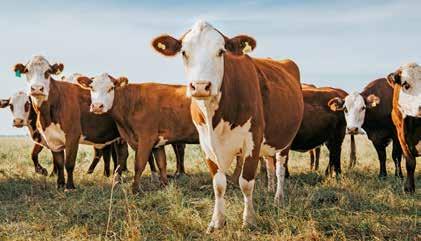
attle continues to be the single largest commodity in Imperial County. Yet, the total Livestock Products commodity category contains additional stand outs.
For instance, Imperial County's Miscellaneous Livestock, valued at $149 milllion, includes a mixed bag of products and cattle, including Wagyu cattle, sales from the California Mid-

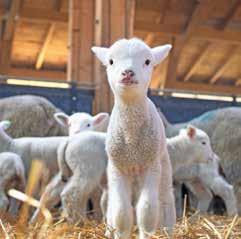
Winter Fair Junior Livestock Auction, and manure/compost. Imperial County topped the state in Miscellaneous Livestock in the most recent data available.
Imperial County's Aquatic Products, valued at $19.5 million, also was higher than any other county in California, according to the most recent state report.
$697,769,000
$616,699,000

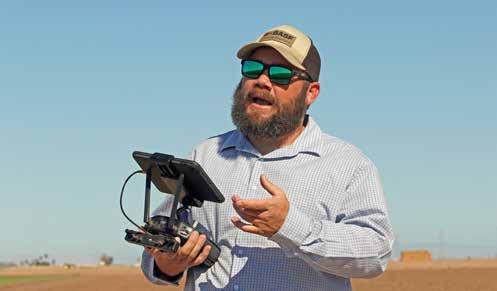
flight pattern, speed, and elevation all programmed into the drone to match the field over which it will fly. The lacewing eggs are mixed in with rice hulls to protect the eggs. They are placed in a drum with adjustable holes, which allow the eggs to be dropped over the field in precise amounts.
The drone used for this beneficial release, at about four feet in circumference, making it larger than an average recreational drone.
Howington said in contracting with Agtegrity, he’ll be using the drone deliveries
on kale, char, leaf lettuce, head lettuce, and spinach. While lettuce and spinach are not long-term crops, he said he wants to make sure the lacewings are in place when the weather warms to combat any increase in aphids.
“As it gets warm, I want to know that the lacewings are already in the plants and ready to explode should the aphids explode,” he said.
While drones have become

increasingly important for the release of beneficial insects, their use in field imaging has provided a key tool for researchers as they analyze factors that cause stress to crops.
“I still do a lot of stress imagery work year-round,” Pate said, adding the four feet by six feet drone used for imaging is different but just as large as the beneficialrelease drone.
Of the imaging, Pate said, “We are using non-visible bands of light to see issues in crops that you cannot see with the naked eye. It’s a way of finding issues that may not be visible yet.” That information guides the PCA and grower to develop plans to maintain a crop’s health and ensure strong yields.
Pate said the use of drones for agriculture has just begun, adding there is great potential to expand its use.
“The biggest thing for me in all of this is that we are looking for technology to meet the practical needs as we go forward in agriculture,” he said. “The drones have many uses today, but there will be more in the future as we move beyond beneficial releases and imaging.” n

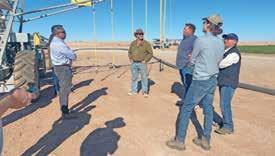




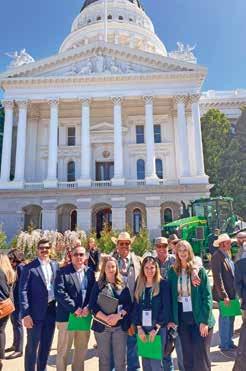

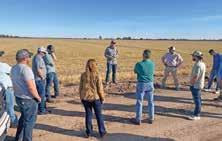


Rockwood Ag Services is a leading independent supplier of crop protection and crop nutritional products in the Desert Southwest.
Rockwood Ag Services provides up-to-date crop consulting with knowledgeable licensed pest control advisors and certified crop advisors. Our team maintains close relationships with manufacturers, universities, private researchers and regulatory agencies to access current information on crop protection methods.
Our PCAs are knowledgeable about farming both conventional and organic crops with sustainable practices. And our crop advisors help create crop nutrition programs for your field, including plant nutrition to help your fields thrive.
Rockwood Ag Services is an owner-member of Integrated Agribusiness Professionals, which is made up of more than 30 independent companies nationally and more recently it joined the CNI group of companies. These affiliations help us maintain a competitive advantage in the retail market.
We hope you will check out our website at www. rockwoodagservices.com. The website provides a chance for you to meet our team, learn more about our services, and peruse a whole host of resources and links to connect you to helpful information.
Rockwood Ag Services works hard to meet the needs of the growers. The firm also is proud to be part of and support the community where we live. That is why you will find us in the stands at the Imperial Valley Mid-Winter Fair & Fiesta's annual livestock

auction supporting local 4H and Future Farmers of America participants. Rockwood Ag Services awards four scholarships and two paid internships to county students pursuing a career in agriculture.
Our staff can also be found participating in California Association of Pest Control Advisors, California Weed Science Society, Rotary, and sponsoring local events around the Imperial Valley, including holding our Rockwood Community Walk and Run 5k and our Annual Desert Agronomy Seminar.
Let Rockwood Ag Services provide all your crop nutrition and crop protection needs in the Imperial Valley. n

Rockwood AG Services Company is a leading independent supplier of crop protection and crop nutrition products in Imperial Valley, providing up-to-date crop consulting with knowledgeable licensed pest control advisors and certified crop advisors.
Rockwood AG Services, formerly known as Rockwood Chemical & Imperial Grain growers, has been serving Imperial Valley since 1922
Licensed Pest Control Advisors and Certified Crop Advisors
Owner-member of Independent Agribusiness Professionals




Crop nutritional programs custom tailored to your crop
Specializing in the right blends of herbicides, pesticides, fungicides and fertilizers
Knowledgeable licensed pest control advisors
All fertilizer product lines and blends, conventional and organic


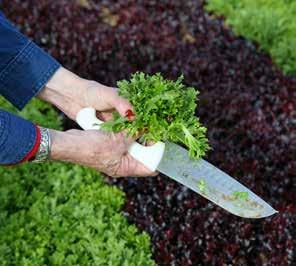

overcoming barriers. That includes proving herself as a woman in agriculture.
The Imperial Valley native graduated Magna Cum Laude from California Polytechnic University with a degree in agricultural business management and certification as a state-licensed pest control advisor (PCA).
She was hired by a local fertilizer/ pesticide company as the first woman in the Valley to work as a “fieldman,” making fertilizer recommendations, checking plant health, calibrating fertilizer and herbicide applications, and running petiole analysis, among other duties.
However, she did not get the same benefits as the other PCAs. For instance, she said, she had to provide her own truck while the men were provided company trucks.
“They hired me, but they didn’t really know what I could accomplish or my dedication and determination,” she said. “What they didn’t understand was that I was raised on a working farm. I drove tractors, cut, raked, and baled hay, learned to irrigate, and worked with cattle. Over time, I proved them wrong. The farmers I worked with respected me, and I went on to become one of their top employees.”
In the decades that followed, she worked as an ag representative and licensed PCA covering Southern California, Arizona, New Mexico, and Hawaii. She also married PCA/ agronomist David Pangle. Throughout her career, she continued to work the family farm with her parents.
In 2012, tragedy struck. Her parents died in a fire that destroyed their home. Pangle took over McConnell Ranch even as she continued to work as an agricultural rep. Eventually, her complete focus became the farming operation.
Throughout her career, Pangle has advocated for Valley agriculture. She was elected to the Farm Bureau Board of Directors in 2012. She also served on the Imperial Valley Vegetable Growers Association Board of Directors, helped found Imperial Valley Water, known as IVH2O, and was a member of the Imperial Irrigation District Water Conservation Advisory Board.
She followed in her parents’ footsteps into leadership roles. Her father was (and to this day remains) the longest-sitting board member of the Farm Bureau. He also served as Farm Bureau president. Her mother



























Thank You TO THE BUYERS AT THE AUCTION AND TO ALL THE RESIDENTS OF OUR VALLEY AND NEARBY COMMUNITIES FOR YOUR SUPPORT!



Thank you to all our SPONSORS, VENDORS & CONCESSIONAIRES
Thank you to HELM AND SONS AMUSEMENTS





See you next year!







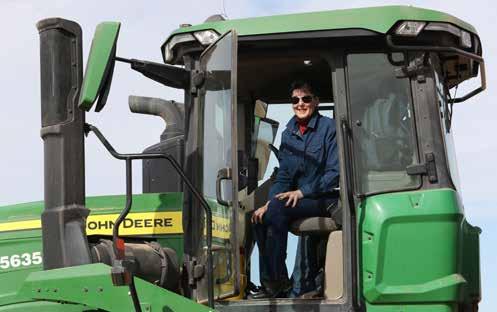
served as president of what once was the Imperial County Farm Bureau Women, which supported the work of the Farm Bureau.
“It’s part of my heritage to get involved and help make agriculture the best it can be,” she said.
At a time when Valley agriculture faces critical Colorado River water negotiations, many local growers are enthusiastic about Pangle assuming the presidency of Farm Bureau.

“She’s there to serve the agriculture community in a fair and balanced way, and I’m sure she’ll distinguish herself as a strong Farm Bureau president,” said farmer Ralph Strahm.
Grower Jack Vessey added, “She’s very good about working with both sides of an issue, listening, and communicating. Her communication style allows people to have

a frank conversation and to find solutions to issues.”
Looking at the year ahead, Pangle said there will be critical issues to address, among them the challenge “to keep enough water in the Imperial Valley to be a thriving agricultural producer and protect the Imperial Valley’s $2.7 billion agricultural industry.”
The full value of Valley agriculture to Imperial County is actually $5.1 billion, based on its multiplier impact on the economy, Pangle noted. In her role as president, Pangle wants to enhance public awareness about the importance of Valley agriculture both locally and nationwide.
“There is a target on Imperial Valley agriculture for using Colorado River water in the desert, but people need to understand that the Imperial Valley and Yuma produce over 80 percent of the winter leafy greens,” Pangle said.
“This is the very best place to grow them while many areas are experiencing freezing weather, and our growers do it and at the same time conserve water to help 40 million people,” she added.
“Our growers are true stewards of the land and water.” n
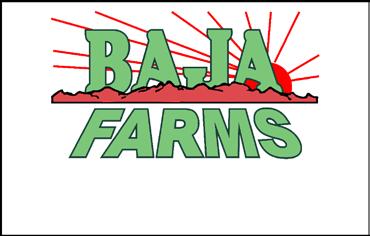


2/Cotton Bales = 500 Pounds.
3/Pastured Crops are pastured once, the acreage is not included
Totals do not add due to rounding.



family and community, which also made a lasting impression.
After graduating from Brawley Union High School in 1977, McBroom attended California Polytechnic University, San Luis Obispo, to major in crop science. His commitment to family brought him back to the Imperial Valley to assist his father with the hay business. But it wasn’t long before he decided to branch out.
“I learned a lot in the hay business, but it was not my passion,” he said. “So, I started working on other farms to cultivate my expertise and get a better understanding of what I wanted to pursue.”
He gained invaluable experience working with prominent Imperial Valley farmers, such as Steve Dahm, Milas Russell, and Don and Larry Cox. His dedication and skill led him to a foreman position with local growers, and in the early 1980s, he advanced to the role of irrigation foreman.
“Eventually, God led me to Allyn Scheu, a local citrus farmer, and my passion for citrus was born,” McBroom said.
He began managing Scheu’s citrus crops and eventually became a partner. At the same time, he started renting fields to farm on his own.
He made his first land purchase in 1997 with his friends Don Emanuelli, Mike

























Sudduth, and Mike Franks, who are all still friends and partners in Osage Citrus.
McBroom established Bloom to Box Crop Care Inc. in 2005. The company now manages more than 9,000 acres of farmland throughout the Imperial and Coachella valleys, specializing in citrus, alfalfa, dates, and peaches.
Family means a great deal to McBroom. He and his wife, Tori, have been married since 1982. They raised two children, Mallory and Marshal, and are grandparents of six. The entire family is involved with Bloom to Box Crop Care, ensuring the continuation of the family’s farming legacy.
“Four of my grandchildren are a quarter mile away, the other two only an hour,” said McBroom. “It is a gift to live and work so closely to my family.”
McBroom’s commitment to the Imperial Valley was a major catalyst to winning Farmer of the Year. His expertise in citrus makes him an asset to trade and research groups throughout California. He is currently chair of the Citrus Research Board and chairs the California Citrus Pest and Disease Prevention Committee.
McBroom has been instrumental in helping both organizations make strides in finding a solution to citrus greening, or
Huanglongbing (HLB), a bacterial infection of citrus plants. He also works closely with communications professionals to support outreach and education campaigns about HLB for homeowners, industry members, and elected officials.
He continues to serve on the Imperial County Farm Bureau Board of Directors as he has for 20 years, including a threeyear term as president. He also served two years as the District 1 Director for the California Farm Bureau Federation and 21 years on the Imperial Irrigation District’s Water Conservation Advisory Board.
In addition to professional connections, McBroom is devoted to his community and faith. He is involved with the Calipatria Community Church and various local ministries.
“We coordinate food drives and support during holidays or times of crisis,” he said. “I go where God needs me.”
McBroom’s commitment to the Imperial Valley remains steadfast.
“The Valley has a lot of opportunity for folks willing to put in the work,” he said. “For me, what’s important is what you do for your family, neighbors, and community when you know no one is looking. That’s what’s important.” n







simply trying to push more product. I wouldn’t call it an experiment, but it kind of is.”
Layaye said increasing acreage is a business decision that helps the industry remain competitive when faced with inflation and new regulations, things neither the growers nor the plant can control.
Colmenero anticipates the expanded production will prove a benefit to Spreckels,
the growers, and the local economy. He thinks the increased production will add from farm fields to Spreckels, as well as trucking and the shipping side of operations.
As for what this expansion means for the future of sugar production in the Imperial Valley, Colmenero said that it is too early to determine. The expansion was part of a one-year contract, and decisions
will have to be made before the next sugar beet crop is planted in September. What this year’s expansion does show, however, is that the Imperial Valley continues to be a leader in the sugar beet industry. Layaye added, “It’s been a long-standing crop in a lot of our rotations. It’s been, on average, over the years, a good crop. As a grower group, we want to maintain that.” n

and Nursery Products may include:

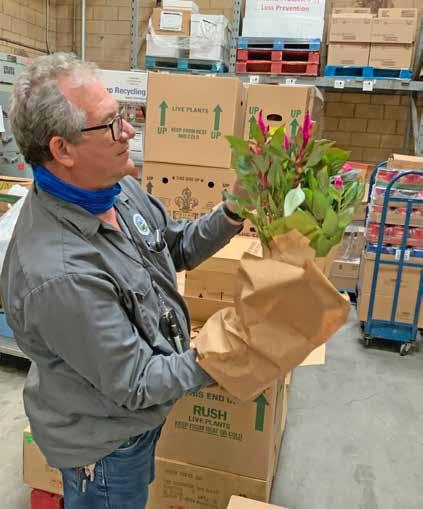

landscapes and potentially triggering eradication activities such as spraying and plant or fruit removal.
The stakes are even higher in the agricultural sector. Crops like citrus and lettuce—staples of both the Imperial Valley's economy and the food supply chain—are highly vulnerable to pests like aphids, beetles, and bacterial diseases. A major pest outbreak can decimate entire harvests, severely impacting the livelihood of farm workers and causing millions of dollars in damages.
The Imperial County Agricultural Commissioner’s office plays a critical role in safeguarding local agricultural productivity by ensuring that imported nursery stock remains free from these threats.
The success of these inspections is not the work of the Agricultural Commissioner’s office alone. It requires strong collaboration with local growers, nurseries, landscapers, state agencies, and the public. Educating residents and businesses about the importance of buying nursery stock from reputable sources and properly inspecting plants before bringing them into the county helps minimize the risk of introducing harmful pests.
In an era of rapid globalization and shifting environmental conditions, the role of the Agricultural Commissioner’s office is more critical than ever.
Inspections of incoming nursery stock stand as a powerful safeguard against the spread of dangerous pests and diseases, ensuring the future health of Imperial County’s landscapes—both urban and agricultural. Through tireless efforts, we continue to protect the county’s economy, environment, and quality of life for generations to come. n



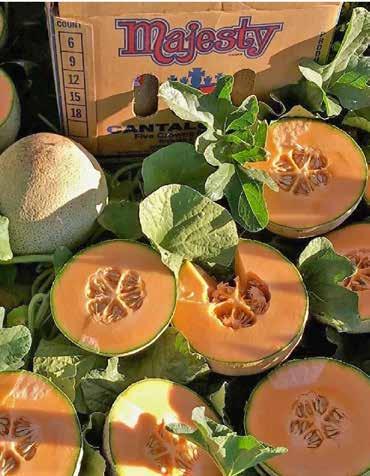
KC Welding and Rentals first opened its doors to serve the people of the Imperial Valley in 1954. Founder Casey Mostrong brought his mechanical skills and ingenuity to the Imperial Valley and opened up shop on Fourth Street, laying the foundation for what is now KC Welding and Rentals.
KC Welding and Rentals later relocated to its current main location at 1549 Dogwood Road, El Centro, in 1963. KC was founded with the vision of producing and supplying top quality agricultural tools and equipment. Casey Mostrong invented and patented various original agricultural tools including vegetable planters, tillage equipment, sled shapes, and cultivators, among other farming products. The company’s agricultural products are a key component in the process that puts fresh, American-grown produce on dinner tables across the nation. It
offers equipment rentals for large-scale commercial applications and small-scale homeowner needs, as well as being an extensive welding and fabrication shop that manufactures custom and original agricultural implements and undertakes any custom fabrication jobs customers
bring in.
KC stocks a wide variety of products in its industrial/agricultural parts supply store. As a provider for industrial applications it also carries and provides commercialgrade steel. The retail store carries popular brand names like Carhartt, Yeti, Traeger, and more.
In 2015, KC expanded, opening a second location in Brawley. A small-scale version of the main facility in El Centro, the Brawley location offers rentals, a retail store, and fabrication services. n
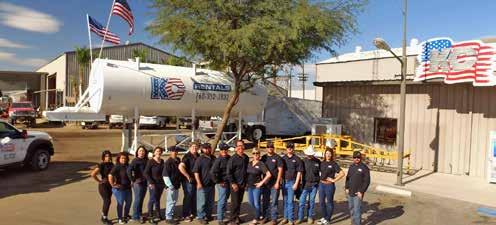



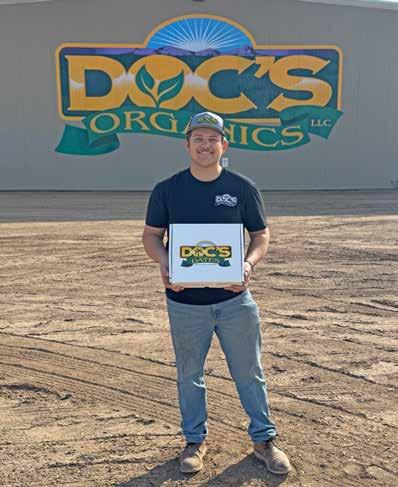
packing shed under Doc’s Organics in 2017 to manage the packing and shipping of its citrus production.
The family’s dates, however, are transported to Coachella where they are stored in freezers for 48 hours, as is required for dates, and then eventually they are shipped to brokers in the Coachella Valley who then market the dates to buyers.
While that will continue to be the primary way the operation’s dates reach customers, selling online through Amazon creates a new outlet with an unlimited customer base.
Dockstader said it has been her goal to work toward building a name for the family’s dates and to build greater awareness of the Valley’s role in date production.
According to the Imperial County Agricultural Commissioner’s

2023 annual crop data, the latest statistics available, the Valley produced nearly 3,000 acres of dates valued at nearly $42 million. And Imperial County is the second largest date growing county in California, according to the state Department of Food and Agriculture.
Selling online is also a way to bring attention to the Valley’s agriculture. For more than a year, P&T Enterprises has made it possible to purchase dates on the operation’s website through Shopify. The website states, “Our mission is to be farmer-direct, getting the freshest quality Organic Medjool Dates to you, when you want them.”
Making the leap to Amazon is the next step. “We are just trying to think outside the box,” Dockstader said, adding a critical component of the effort is highlighting that the dates come from the Imperial Valley as opposed to the Coachella Valley. Hence, the logo placed on each box of dates sold online.
Spearheading the effort is Gina Dockstader’s son, Tanner Dockstader, who has joined the family farming operation as head of special projects as well as becoming involved in other aspects of the family farm. He also is a salesman for the operation’s fruit commodities.
She said of his work on Amazon marketing, “His role has been to get it up and running, manage it, and handle the shipping when orders come in. It’s nice to have my son be a part of the family business.”
Using Amazon, she said, fits the growing farm-to-table trend.
“What it does is provide a face to the fruit they are eating,” Dockstader said. “They can see the dates they are enjoying have come from our family farm and from the Imperial Valley.”
As her farming operation looks ahead, she said the goal is to focus on selling the dates online because dates are a fruit that can handle the varied temperatures that might occur in the direct shipping process.
The goal is also to work on the marketing to ensure the customers know to look for Doc’s Dates on Amazon.
“This is a pet project for us,” she said. “We are still in the early stages.”
For now, Doc’s Dates are sold on Amazon in 5-pound quantities for $45 and 11 pounds at $70. She said going forward, she anticipates selling dates in smaller quantities, which might appeal to different consumers.
“While we are just beginning with Amazon, we look forward to seeing how it helps us build our brand and to ensure the Imperial Valley is recognized for our crops, including date production,” Dockstader said. n





grow but also still directly supports one out of every six jobs in the county,” Dessert said.
The latest report also acknowledges ongoing shifts in statewide agricultural employment. It notes mechanization and globalization have led to a gradual decline in job numbers in Imperial County and other California counties.
This has been attributed to new technologies, including GPS, drones, robotics, and artificial intelligence, that continue revolutionizing farming practices and reducing reliance on traditional labor. Despite that, agriculture continues to be a critical source of employment in the county.
Meanwhile, imported agricultural products from Mexico further intensify competition for local producers.
As the county’s largest industry, agriculture’s continued growth and diversification are vital for the region’s economic health.
Investments in technology and infrastructure will be crucial to maintaining competitiveness in a globalized market. Policymakers and stakeholders must also address the challenges of mechanization and globalization to sustain employment and support local producers.
Langholz said residents and visitors to the Valley “can easily see that agriculture plays a vital role in the local economy. What I hope they realize—and what our Crop Report Plus studies quantify—is that agriculture is an even more important economic engine than they thought.” n





Same old gets you same old. That’s why Fendt does things differently. Always innovating new and better ways to improve your bottom line, from the fuel-maximizing Fendt iD low-speed concept to VarioDrive stepless CVT making manual all-wheel drive a thing of the past. The only question left is, are you looking to the future?
Gr ow bold .
